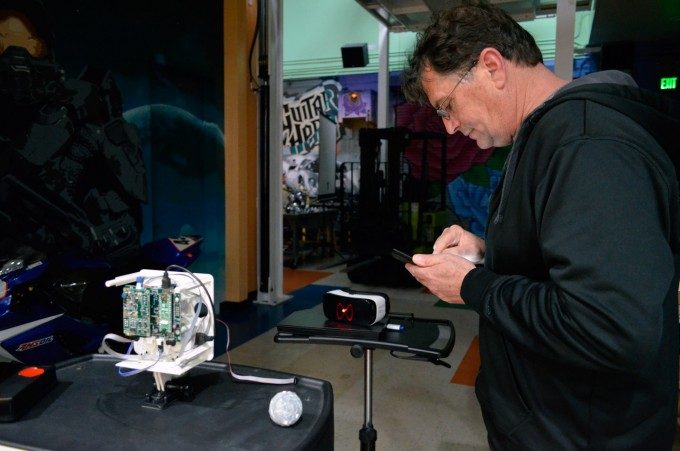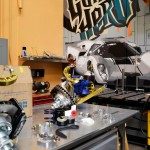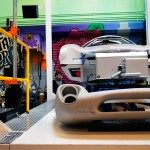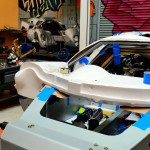Tracking is the foundation of great virtual reality. Knowing the position and orientation of the user’s head is essential to being able to move the virtual world convincingly around them as they move through it. Oculus and Valve/HTC have the leading tracking systems (dubbed ‘Constellation’ and ‘Lighthouse’, respectively), but soon a new entrant could join the VR tracking arena.
Into the Workshop
It’s an unusually rainy day in the hills of Livermore, CA, as I stroll down a row of small connected office buildings. Door after door with company logos prominently featured in the windows, but it isn’t until I find the door identified with only a small oval sticker that I stop. Collectors hoarding VR memorabilia 50 years from now might recognize the sticker—adorned with the letters ‘VR’ in the center and tiny ‘Oculus’ text at bottom—as one given out by the company in its earliest days. Fittingly, behind the door is the personal workshop of one of company’s earliest employees.
Jack McCauley served as Oculus’ VP of Engineering up through the Rift DK2. He was among four employees featured in the company’s 2012 Kickstarter video (not counting John Carmack and Michael Abrash, who would both join years later). Much of the footage from the Kickstarter video was actually shot in McCauley’s workshop where I am now standing.
By some definitions (including his) McCauley is a co-founder of Oculus due to his contributions and status as one of the earliest hires, though as far as Oculus itself is concerned, the company represents Palmer Luckey as the one and only “Founder” (with a capital F). As a seasoned design engineer who played an instrumental role in the creation of the Guitar Hero peripherals, McCauley brought hardware design experience to the young company, which was about to embark on designing, manufacturing, and delivering thousands of Rift DK1 headsets to eager backers of the crowdfunding campaign.
McCauley takes me through a small lobby space, which is adorned with Guitar Hero and Oculus related placards of recognition, into what he calls ‘McCauley Labs.’ “Lab,” I suppose, because what goes on inside is not just crafting, but much experimentation, and “McCauley Labs,” (in the form of a business title) perhaps because he employs several staff members who have complementary expertises, and explore projects he doesn’t quite have time for.
The workshop is a veritable wonderland for the hacker/maker type, littered with industrial-grade equipment that McCauley uses for work and hobbies alike. As I make my way to the back of the space, I see that the workshop’s walls are covered with graffiti-style art with characters and logos from video games, including a prominent depiction of a Lola T70 sports car.
McCauley positions himself at the edge of a large open space near a garage door in the back of the workshop and asks me to step aside. As I clear the area, a car elevator—the kind you would find in a parking garage—begins to lower from overhead. McCauley had the lift installed so that he could store his vehicles on the second floor of his office. As the lift reaches the ground, I see the project that’s currently occupying much of his time: a half-finished Lola T70, the same one from the wall. McCauley is building his own, mostly from the ground up, and he plans to race it when he’s done. He points out that the chassis is the same geometry as the original, but this one is TIG welded instead of riveted.
It’s clear at this point that McCauley is very hardware oriented, but a tinge of tech begins to shine through as he explains his plan to build the steering wheel to accommodate an Android tablet which will talk to the car’s engine via Bluetooth, displaying all its vitals in a central location. When I ask if he knows yet which app he’ll use for that purpose, he tells me he plans to write his own.
What I Came to See
At this point McCauley returns the lift to the second floor and we head back to the middle of the workshop. Amidst huge tool boxes and complex machinery is a small 3D printed white enclosure attached to a wheeled worktray by a GoPro mount. This is what I came to see.
The face of the enclosure is about the surface area of a square box of tissues, but only about a quarter as deep. The back is seemingly missing a rear plate, which gives a clear view of an array of circuit boards and wires. Like Valve’s Lighthouse system, this is a laser-based tracking system. But unlike Lighthouse—which sweeps the room with lasers regardless of what’s in the area—this one actively seeks its intended target.
The MEMS Tracking System (or MTS, which I’m going to call it for ease of use) shoots its laser in a unique way compared to Lighthouse. Lighthouse uses lenses to stretch the laser’s landing area from a point into a line, then it sweeps those lines around a space by mounting the lenses on precisely spinning motors. MTS on the other hand, uses a tiny mirror (which tilts but doesn’t spin) to point the laser in any singular direction.
![]()
When initialized, MTS begins scanning a cone area in front of it in a grid-like pattern to search for its target. The target it’s looking for is a point of high reflectivity, measured by the amount of laser light that’s returning to the origin point. Of course, the laser could stop on any slightly reflective surface, so you need to make sure that the target is much more reflective than anything else in the environment, then set a minimum floor for detection, such that the laser continues to scan until a sufficiently bright reflection is found. A retroreflective marker, placed on a headset or motion controllers, serves as that sufficiently bright object, ensuring that much of the laser’s energy is reflected back to the receiver.

For a proof of concept, MTS is impressive. When McCauley first demonstrated the system, a small spherical marker attached to a Gear VR headset was sitting about 5 feet away. He turned on the MTS basestation and I watched as the laser slowly indexed the scene looking for its target. It started, quite logically, at the top left, and ran horizontally until reaching its right-most limit, then returned to the left, dropped down slightly, and continued from there, line-by-line. When it reached the marker on the headset, it stopped. The initial scan took 4 or 5 seconds. So at this point I figured MTS was a neat concept, but there was still much work to be done to reduce 5 second cycle down to mere milliseconds so that the tracking would be fast enough for practical use.
It wasn’t until McCauley picked up the headset and started moving it around, with the laser continuously fixed on the marker, that I realized the initial scan was probably slowed down for human benefit, and that MTS was already capable of high speed tracking.
Once the marker is found, the mirror continuously aims the laser at the object as it moves, constantly seeking the point of most intense reflectivity. Assuming this can be achieved robustly, tracking the object’s position on an XY coordinate plane is as easy as reading the angle of the mirrors that are aiming the laser. With one additional marker on the tracked object, or an additional MTS basestation, you now have all the angles needed to triangulate the object’s XYZ position.










